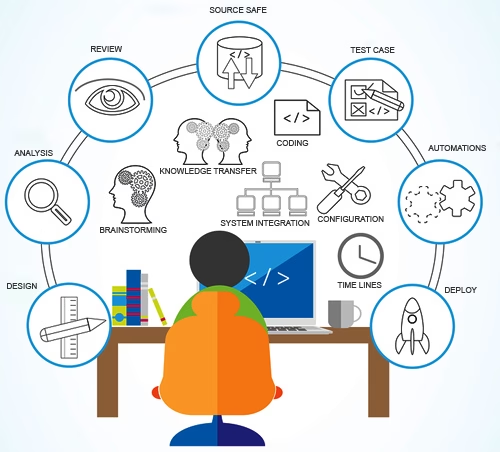- Developers
- Developer Blog
- AI Software Development
- How to Build Hyperautomation Tools?

profile

By Aran Davies
Verified Expert
8 years of experience
Aran Davies is a full-stack software development engineer and tech writer with experience in Web and Mobile technologies. He is a tech nomad and has seen it all.
Do you plan to build hyperautomation tools? Hyperautomation is a happening space. Building hyperautomation tools can be complex though. Take the following steps:
1. Form a small team to initiate, define, and plan the project to build a hyperautomation platform
You need a crack team to get the project started on the right track. Expect a hyperautomation development project to be complex.
Hyperautomation uses cutting-edge technologies like artificial intelligence (AI), machine learning (ML), natural language processing (NLP), and robotic process automation (RPA). It also utilizes advanced analytics. Projects involving that many advanced technologies tend to be highly complex.
You need the right preparation to succeed in such automation efforts. Effective project initiation, definition, and planning make a difference in automation initiatives like this.
Form a small team led by an experienced and capable project manager (PM). You need a skilled software architect with hyperautomation experience. Furthermore, you need a small team of business analysts (BAs).
This team should keep the hyperautomation strategy of your organization in mind. The team should identify hyperautomation opportunities accordingly.
The PM should lead the project initiation, definition, and planning activities. BAs should gather, analyze, and document the business requirements. You need the architect to define the non-functional requirements (NFRs), furthermore, the architect should create technical solutions.
2. Gather, analyze, document, finalize, and manage the hyperautomation requirements
Do the following to gather, finalize and manage the project requirements:
2A. Identify the priorities of the end-users
Who are your end-users? What do they want from hyperautomation? High-level answers to these questions could be the following:
- “End-users want improved business results”.
- “Organizations want employee performance improvement.”
- “Companies want to boost the productivity of knowledge workers.”
- “Organizations want to reduce manual tasks with the help of end-to-end automation”.
However, go beyond these high-level answers.

Get a complimentary discovery call and a free ballpark estimate for your project
Trusted by 100x of startups and companies like
Where will hyperautomation help them? What will deliver sustained value to end-users? Analyze these questions in detail.
In this exercise, you might identify several priority areas. These could be as follows:
- Automating business processes;
- Digital process automation;
- Intelligent business process management;
- Automating repetitive tasks and manual processes;
- Process optimization to reduce manual efforts;
- The ability to gather insights from seemingly disconnected data points.
2B. Analyze how the key aspects of hyperautomation can help the end-users
You now need to analyze how hyper automation capabilities can help users with their priority areas. The key hyper automation capabilities are as follows:
- Intelligent process discovery;
- Robotic process automation (RPA);
- Analytics and insights;
- Intelligent document processing.
2C Gather the business requirements
BAs in your team need to gather business requirements. They might need to do the following:
- Interviewing end-users;
- Brainstorming with business stakeholders in your organization;
- Analyzing market research reports;
- Conducting market surveys.
Identify the target platforms for the proposed hyperautomation platform. E.g. you might choose to offer web, Android, and iOS apps.
2D. Gather the non-functional requirements (NFRs)
You need the architect to identify the NFRs. Examples of NFRs are performance, scalability, maintainability, and security. The architect should study industry benchmarks and standards to decide on the NFRs.
2E. Document, review, finalize, and manage the requirements
Your team needs to effectively document the functional and non-functional requirements. You need the PM to implement requirement reviews. The PM should obtain approval for requirements, and a change management process is necessary.
3. Plan the features of your MVP (minimum viable product)
You have finalized the requirements, and you have zeroed in on the features to offer. Your team has identified several automation opportunities. You now need to validate your product idea.
Find out if it’s a viable product idea. Launch an MVP (minimum viable product) for that. MVPs are functional products, however, you offer fewer features in an MVP.
You develop and launch an MVP quickly. This helps you to get market feedback. Based on the feedback, you can plan the further development roadmap. You might even need to go back to the drawing board.
Which features should you offer in the MVP? Analyze the impact and ease of implementation of the features you have planned for the final product. Identify the features with the highest impact and ease of implementation. Plan to offer them in the MVP.
4. Decide on the technology stack
You might need to use multiple technologies depending on the project scope and requirements. Chose the technology stack for the following software development work streams:
4A. Web development
We recommend you use JavaScript for front-end web development. You can use this open-source programming language along with HTML and CSS. Alternatively, you can use a JavaScript web framework like Angular or React.
You can develop the web backend using one of several languages like Java, Python, Ruby, and Golang. All of them offer several advantages.
Alternatively, you can use Node.js for backend development. This open-source runtime environment is based on JavaScript. This amounts to using JavaScript for the entire web development.
4B. Mobile development
We recommend you use native Android and iOS apps. Cross-platform app development can help you to control software development costs due to only one codebase and code reuse. However, cross-platform apps can’t match the user experience, performance, and security of native apps.
We recommend you use Java for native Android development. Java doesn’t need an introduction. Many developers have used it for native Android development, therefore, you will find programmers easily.
Hire expert developers for your next project
1,200 top developers
us since 2016
Alternatively, you can use Kotlin for native Android development. It’s a powerful and modern language. This open-source language has many of the strengths of java. However, it’s a relatively new language. You might need more time to hire Kotlin developers.
We recommend you use Swift for native iOS development. Apple increasingly wants developers to use this modern, feature-rich, and powerful language for developing apps for its platforms. Programmers earlier used Objective-C to develop iOS apps. However, Swift has clearly eclipsed Objective-C in popularity.
4C. Databases
You can use either MySQL or PostgreSQL if you need an RDBMS (relational database management system). Both MySQL and PostgreSQL are popular and powerful SQL databases.
Do you need a NoSQL database? Use MongoDB or Apache Cassandra. Both of these open-source NoSQL databases are highly scalable.
4D. API development
You will likely develop your own APIs for the core functionalities. Multiple standards exist for API development. REST (Representational State Transfer) is the de-facto standard for API development.
GraphQL is a newer and more powerful alternative. GraphQL helps you to create more efficient APIs. However, more developers are familiar with REST API development than GraphQL. Choose a standard based on your project and organizational requirements.
4E. AI (artificial intelligence), ML (machine learning), RPA (robotic process automation), analytics, and big data development
Hyperautomation uses multiple cutting-edge technologies. Within the umbrella of AI, it might use ML, NLP (natural language processing), and computer vision. Within computer vision, you might use technologies like optical character recognition.
You will use RPA when developing hyperautomation solutions. Big data and analytics form the other key components of hyperautomation.
Programming languages
We recommend you use Python. This open-source language is very popular for AI/ML development. It’s also a popular choice for data science and analytics projects.
Python has powerful libraries for AI/ML/analytics development, e.g., Scikit-Learn. These libraries include standard implementations of important ML algorithms. Therefore, you can easily create machine learning models with them.
AI/ML development platforms
You can expedite the project with AI development platforms that harness the power of cloud computing. Check out the following AI development tools:
- Microsoft Azure AI Platform;
- Google Cloud AI Platform;
- IBM Watson;
- Infosys Nia;
- Dialogflow;
- BigML.
Big data frameworks
You need a robust big data framework for a hyperautomation development project. Explore Hadoop, a highly popular open-source big data framework. Use the following tools with it:
- HDFS (Hadoop Distributed File System);
- HIVE;
- NoSQL;
- Mahout;
- Avro;
- Spark.
5. Create the project plan
You need the PM to create an effective project plan. The project plan should take into account important tasks in AI/ML projects, e.g.:
- Data collection;
- Data exploration;
- Organizing data sets in the appropriate format;
- Improving the data quality;
- Feature engineering;
- Creating training and testing data sets;
- Training ML algorithms;
- Testing ML algorithms.
You also need the plan to cover generic areas like risk management, human resource management, quality management, estimation, scheduling, communications management, etc.
6. Hire developers and form a software development team to build hyperautomation tools
You now need to hire developers and form a team. Focus on the following aspects:
A. Identifying the right roles
You need to hire people for the following roles:
- User interface (UI) designers;
- Web developers;
- Native Android developers;
- Native iOS developers;
- Python developers with AI/ML/RPA/analytics experience;
- Testers;
- DevOps engineers.
B. Hiring competent people from the right source
We recommend you hire expert developers from hybrid software development companies like DevTeam.Space. You get the following advantages:
Hire expert developers for your next project
- Companies like DevTeam.Space offer full-time developers. You need dedicated developers for complex projects like this.
- Such companies use effective screening processes. You get highly skilled developers.
- Developers from these companies work on a wide range of projects, therefore, they are experienced.
- Companies like DevTeam.Space offer top-notch professional development opportunities. They keep their programmers motivated.
- You get management support from these companies. E.g., they provide replacement developers in the case of turnovers.
Do you plan to hire from freelance platforms? We don’t recommend that for projects of this complexity. Freelancers work only part-time on a project, and you might not get enough of their bandwidth.
You might find it hard to manage the work of remote freelancers. Different freelancers will work in silos. You might find it hard to integrate their work.
Freelancers might leave a project mid-way. You need to hire replacements since freelance platforms don’t offer any management support.
C. Forming an effective team
Now that you have hired developers, you need to form an effective team. The team should focus on adding sustained value to clients. You need an empowered team that collaborates well.
We recommend you use the scrum framework to form and manage such teams. You need a scrum master to lead the team. Scrum teams are small and cross-functional teams, where developers and testers work together.
Scrum teams work on iterations called “sprints”. A product owner provides the requirements and maintains a product backlog. A scrum team estimates features and plans them in sprints. This exercise is called the “sprint planning meeting”.
Scrum teams conduct a “daily stand-up meeting” to discuss the project status. They resolve project issues here too.
You get the sprint approval in a “sprint review meeting”. The scrum team demonstrates the product during this meeting.
You need a lessons-learned exercise. Scrum teams conduct a “sprint retrospective meeting” for this after a sprint. You foster an environment of client focus, collaboration, and empowerment.
7. Execute, monitor, and control the software development project
You need the PM to lead the project execution. The high-level tasks are as follows:
- Data collection and exploration;
- Organizing data sets in the appropriate format and improving the data quality;
- Feature engineering;
- Creating training and testing data sets;
- Training ML algorithms and testing them;
- Coding other AI, RPA, and analytics modules;
- UI design for the web and mobile apps;
- Web development;
- Native Android development;
- Native iOS development;
- Code review;
- Testing;
- Deployment;
- Post-deployment support.
8. Assess the organization’s success after the implementation of hyperautomation
Did you achieve success from the hyperautomation implementation? You can answer this question by measuring a few key performance indicators (KPIs). These are as follows:
- Customer satisfaction (CSAT);
- Retention rate;
- Customer churn;
- Conversion rate;
- Customer lifetime value;
- Customer acquisition costs (CAC);
- The number of support tickets created;
- Daily active users (DAUs);
- Monthly active users (MAUs);
- Bounce rate;
- Monthly recurring revenue (MRR);
- The average revenue per user (ARPU);
- Net promoter score (NPS).
Want smart developers to build hyperautomation tools? Contact DevTeam.Space.
FAQs
There’s a growing market for hyperautomation. Acumen Research and Consulting estimates the hyper automation market to reach $32.632 billion by 2030. Its market research report projects a CAGR of 18.7% during the 2022-2030 period.
The top companies in the hyperautomation market are Tata Consultancy Services Ltd., UiPath, Automation Anywhere Inc., Appian, OneGlobe LLC, Catalytic Inc., and SolveXia.
The top hyperautomation solutions are Automation Anywhere, UiPath, Celonis, Intercom, Alteryx, and ProcessMaker.

Alexey Semeney
Founder of DevTeam.Space
Hire Alexey and His Team To Build a Great Product
Alexey is the founder of DevTeam.Space. He is award nominee among TOP 26 mentors of FI's 'Global Startup Mentor Awards'.
Alexey is Expert Startup Review Panel member and advices the oldest angel investment group in Silicon Valley on products investment deals.


